
Oh, how the headlines blared:
“…the 2016 bot paradigm shift is going to be far more disruptive and interesting than the last decade’s move from Web to mobile apps.”
Chatbots were The Next Big Thing.
Our hopes were sky high. Bright-eyed and bushy-tailed, the industry was ripe for a new era of innovation: it was time to start socializing with machines.
And why wouldn’t they be? All the road signs pointed towards insane success.
Messaging was huge! Conversational marketing was a sizzling new buzzword! WeChat! China!Plus, it was becoming clear that supply massively exceeded demand when it came to those pesky, hard-to-build apps.
In fact, the only significant question around chatbots was who would monopolize the field, not whether chatbots would take off in the first place:
“Will a single platform emerge to dominate the chatbot and personal assistant ecosystem?”
One year on, we have an answer to that question.
No.
Because there isn’t even an ecosystem for a platform to dominate.
Fooled by another hype cycle
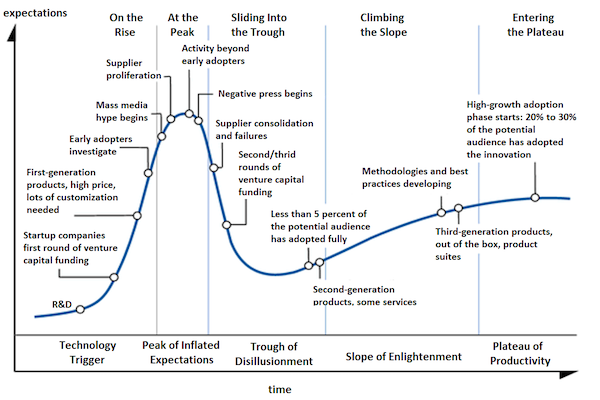
Chatbots weren’t the first technological development to be talked up in grandiose terms and then slump spectacularly.
The age-old hype cycle unfolded in familiar fashion…
Reverential TechCrunch articles were written.Prophetic thought leaders like Chris Messina chimed in.Silicon Valley salivated at the prospect of talking to smart automation.Messenger began to overflow with bots.Slack went through exponential growth and even launched a fund for bot investment.
Expectations built, built, and then….. It all kind of fizzled out.
The predicted paradim shift didn’t materialize.
And apps are, tellingly, still alive and well.
We look back at our breathless optimism and turn to each other, slightly baffled:
“is that it? THAT was the chatbot revolution we were promised?”
Digit’s Ethan Bloch sums up the general consensus:
“I’m not even sure if we can say ‘chatbots are dead,’ because I don’t even know if they were ever alive.”
According to Dave Feldman, Vice President of Product Design at Heap, chatbots didn’t just take on one difficult problem and fail: they took on several and failed all of them.
Text vs. Speech vs. GUI: a potted history
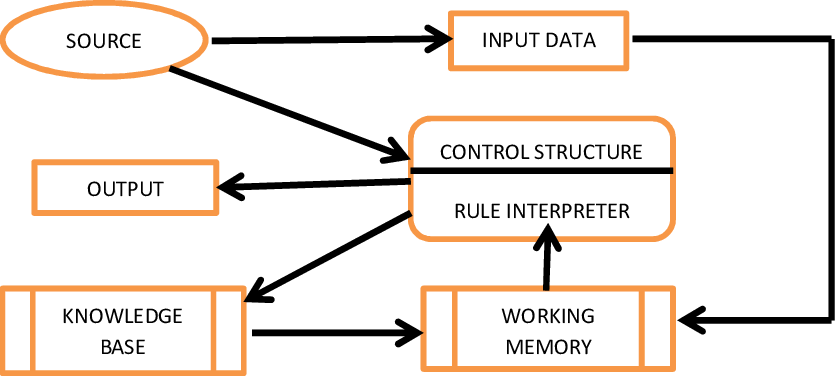
Bots can interface with users in different ways. The big divide is text vs. speech. In the beginning (of computer interfaces) was the (written) word.
Users had to type commands manually into a machine to get anything done.
Then, graphical user interfaces (GUIs) came along and saved the day. We became entranced by windows, mouse clicks, icons. And hey, we eventually got color, too!
Meanwhile, a bunch of research scientists were busily developing natural language (NL) interfaces to databases, instead of having to learn an arcane database query language.
Another bunch of scientists were developing speech-processing software so that you could just speak to your computer, rather than having to type. This turned out to be a whole lot more difficult than anyone originally realised:
… so many different accents, people speaking too fast or too slowly, mumbling, umming and aahing.Did you say “recognise speech” or “wreck a nice beach”?
The next item on the agenda was holding a two-way dialog with a machine. Here’s an example dialog (dating back to the 1990s) with VCR setup system:
User: “Hello.”Agent: “Hello, what’s your name?”User: “Candy.”Agent: “Hello, Candy!”User: “Let’s set the clock.”Agent: “What is the time?”User: “The time is 11:00 AM.”Agent sets the clock to 11:00 AM.
Pretty cool, right? The system takes turns in collaborative way, and does a smart job of figuring out what the user wants.
It was carefully crafted to deal with conversations involving VCRs, and could only operate within strict limitations.
Modern day bots, whether they use typed or spoken input, have to face all these challenges, but also work in an efficient and scalable way on a variety of platforms.
Basically, we’re still trying to achieve the same innovations we were 30 years ago.
Here’s where I think we’re going wrong:
Thinking in terms of Bots vs. Apps
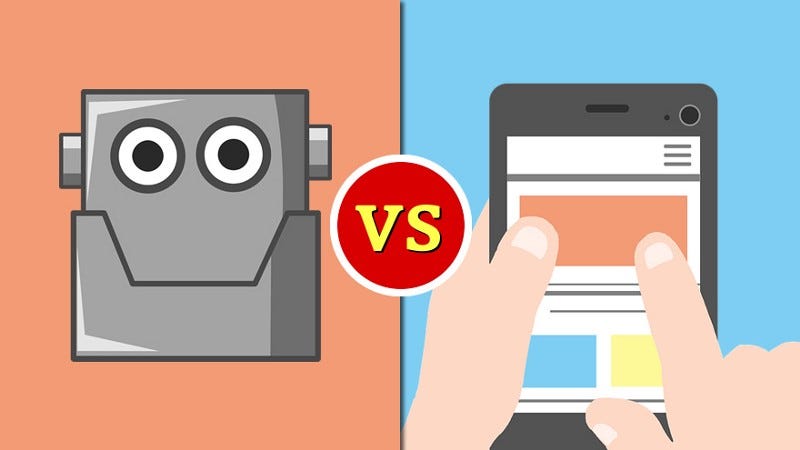
An oversized assumption has been that apps are ‘over’, and would be replaced by bots.
By pitting two such disparate concepts against one another (instead of seeing them as separate entities designed to serve different purposes) we discouraged bot development.
You might remember a similar war cry when apps first came onto the scene ten years ago: but do you remember when apps replaced the internet?
It’s said that a new product or service needs to be two of the following: better, cheaper, or faster. Are chatbots cheaper or faster than apps? No — not yet, at least.
Whether they’re ‘better’ is subjective, but I think it’s fair to say that today’s best bot isn’t comparable to today’s best app.
Plus, nobody thinks that using Lyft is too complicated, or that it’s too hard to order food or buy a dress on an app. What is too complicated is trying to complete these tasks with a bot — and having the bot fail.
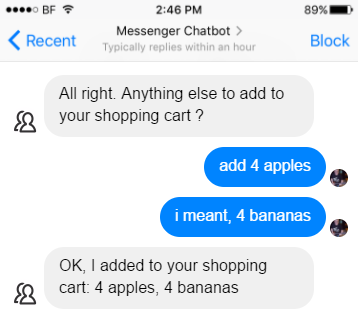
A great bot can be about as useful as an average app. When it comes to rich, sophisticated, multi-layered apps, there’s no competition.
That’s because machines let us access vast and complex information systems, and the early graphical information systems were a revolutionary leap forward in helping us locate those systems.
Modern-day apps benefit from decades of research and experimentation. Why would we throw this away?
But, if we swap the word ‘replace’ with ‘extend’, things get much more interesting.
Today’s most successful bot experiences take a hybrid approach, incorporating chat into a broader strategy that encompasses more traditional elements.

- Penny provides chatty advice and alerts alongside a traditional account dashboard and transaction list.
- HubSpot Conversations unifies Facebook Messenger, onsite chat, social media, email and other messaging outlets into one shared inbox.
- Layer gives developers the tools to create personalized messaging experiences on mobile web and desktop web as well as native apps.
The next wave will be multimodal apps, where you can say what you want (like with Siri) and get back information as a map, text, or even a spoken response.
Bots for the sake of bots
Does my product need a bot? Are existing platforms able to support its functionality? Do I have the patience to build a bot that’s capable of doing what I want it to?
Another problematic aspect of the sweeping nature of hype is that it tends to bypass essential questions like these.
For plenty of companies, bots just aren’t the right solution. The past two years are littered with cases of bots being blindly applied to problems where they aren’t needed.
Building a bot for the sake of it, letting it loose and hoping for the best will never end well:

The vast majority of bots are built using decision-tree logic, where the bot’s canned response relies on spotting specific keywords in the user input.
The advantage of this approach is that it’s pretty easy to list all the cases that they are designed to cover. And that’s precisely their disadvantage, too.
That’s because these bots are purely a reflection of the capability, fastidiousness and patience of the person who created them; and how many user needs and inputs they were able to anticipate.
Problems arise when life refuses to fit into those boxes.
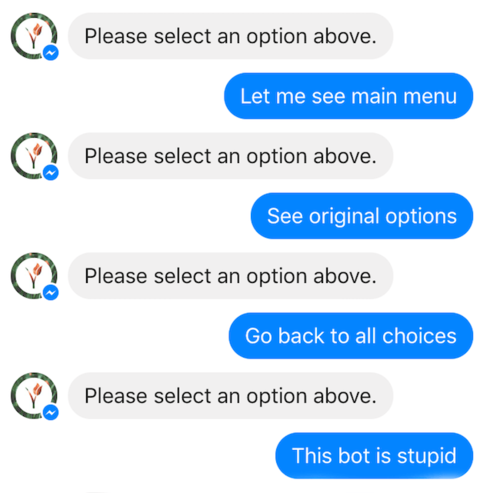
According to recent reports, 70% of the 100,000+ bots on Facebook Messenger are failing to fulfil simple user requests. This is partly a result of developers failing to narrow their bot down to one strong area of focus.
When we were building GrowthBot, we decided to make it specific to sales and marketers: not an ‘all-rounder’, despite the temptation to get overexcited about potential capabilties.
Remember: a bot that does ONE thing well is infinitely more helpful than a bot that does multiple things poorly.
Inaccessibility
A competent developer can build a basic bot in minutes — but one that can hold a conversation? That’s another story. Despite the constant hype around AI, we’re still a long way from achieving anything remotely human-like.
Inan ideal world, the technology known as NLP (natural language processing) should allow a chatbot to understand the messages it receives. But NLP is only just emerging from research labs and is very much in its infancy.
Some platforms provide a bit of NLP, but even the best is at toddler-level capacity (for example, think about Siri understanding your words, but not their meaning.)
As Matt Asay outlines, this results in another issue: failure to capture the attention and creativity of developers.
“Consumer interest was never going to materialize until machine intelligence could get anywhere near human intelligence.User interest depends upon AI that makes talking with a bot worthwhile for consumers.”
And conversations are complex. They’re not linear. Topics spin around each other, take random turns, restart or abruptly finish.
Today’s rule-based dialogue systems are too brittle to deal with this kind of unpredictability, and statistical approaches using machine learning are just as limited. The level of AI required for human-like conversation just isn’t available yet.
And in the meantime, there are few high-quality examples of trailblazing bots to lead the way. As Dave Feldman remarked:
“Should Slack, Facebook, Google, Microsoft, Kik, and others have built their own built-in bots to lead the way?Should they have gotten more proactive with their bot funds and incubators, hiring mentors to educate participants in the Way of the Bot, or supplying engineering and design resources? Funded Strategic Bot Initiatives at high-profile partners?In my opinion yes, yes, and yes. When it comes to platforms, developers are the users; and we don’t rely on our users to understand why or how to use our products. We have to show them.”
GUI shouldn’t be dismissed
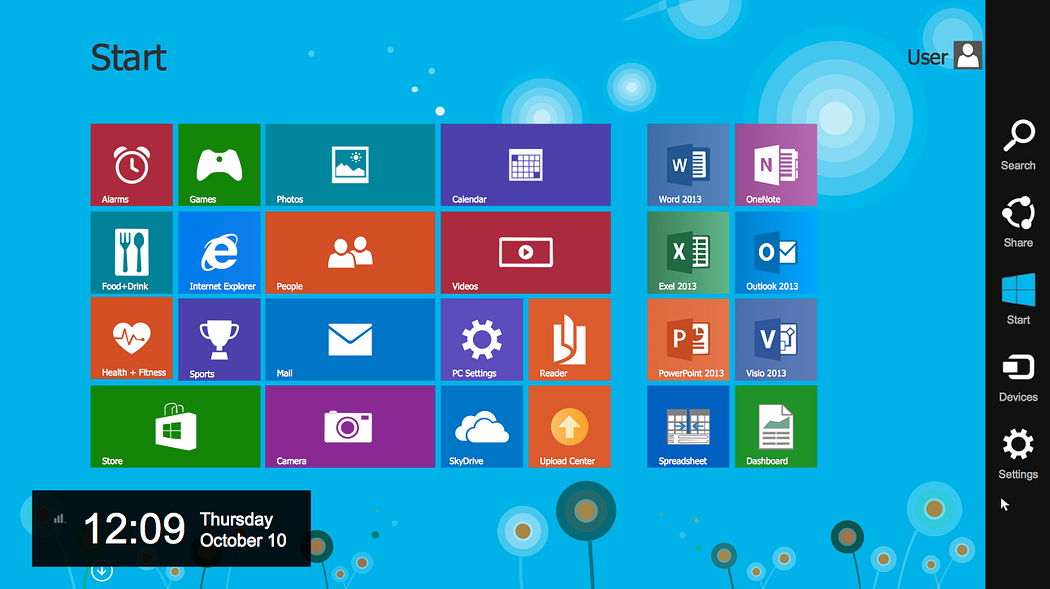
Once upon a time, the only way to interact with computers was by typing arcane commands to the terminal. Visual interfaces using windows, icons or a mouse were a revolution in how we manipulate information
There’s a reasons computing moved from text-based to graphical user interfaces (GUIs). On the input side, it’s easier and faster to click than it is to type.
Tapping or selecting is obviously preferable to typing out a whole sentence, even with predictive (often error-prone ) text. On the output side, the old adage that a picture is worth a thousand words is usually true.
Welove optical displays of information because we are highly visual creatures. It’s no accident that kids love touch screens. The pioneers who dreamt up graphical interface were inspired by cognitive psychology, the study of how the brain deals with communication.
Conversational UIs are meant to replicate the way humans prefer to communicate, but they end up requiring extra cognitive effort. Essentially, we’re swapping something simple for a more-complex alternative.
Sure, there are some concepts that we can only express using language (“show me all the ways of getting to a museum that give me 2000 steps but don’t take longer than 35 minutes”), but most tasks can be carried out more efficiently and intuitively with GUIs than with a conversational UI.
Humans like talking to other humans
Aiming for a human dimension in business interactions makes sense.
If there’s one thing that’s broken about sales and marketing, it’s the lack of humanity: brands hide behind ticket numbers, feedback forms, do-not-reply-emails, automated responses and gated ‘contact us’ forms.
Facebook’s goal is that their bots should pass the so-called Turing Test, meaning you can’t tell whether you are talking to a bot or a human. But a bot isn’t the same as a human. It never will be.
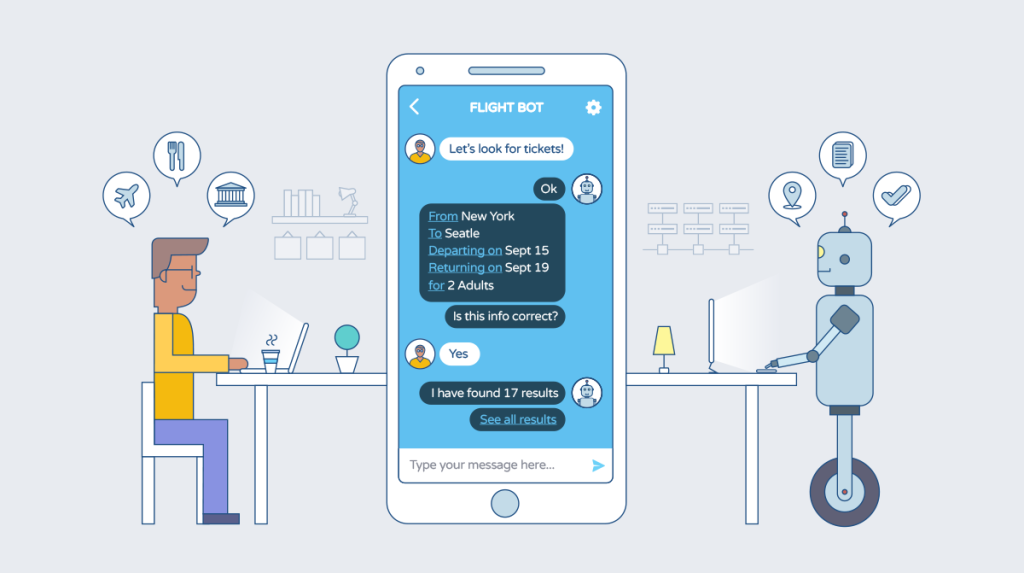 A conversation encompasses so much more than just text.
A conversation encompasses so much more than just text.
Humans can read between the lines, leverage contextual information and understand double layers like sarcasm. Bots quickly forget what they’re talking about, meaning it’s a bit like conversing with someone who has little or no short-term memory.
As HubSpot team pinpointed:
Bots provide a scalable way to interact one-on-one with buyers. Yet, they fail when they don’t deliver an experience as efficient and delightful as the complex, multi-layered conversations people are accustomed to having with other humans on messaging apps.
People aren’t easily fooled, and pretending a bot is a human is guaranteed to diminish returns (not to mention the fact that you’re lying to your users).
And even those rare bots that are powered by state-of-the-art NLP, and excel at processing and producing content, will fall short in comparison.
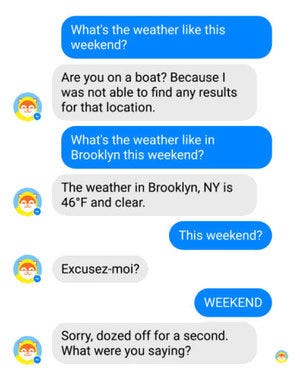
And here’s the other thing. Conversational UIs are built to replicate the way humans prefer to communicate — with other humans.
But is that how humans prefer to interact with machines?
Not necessarily.
At the end of the day, no amount of witty quips or human-like mannerisms will save a bot from conversational failure.
Where do we go from here?
In a way, those early-adopters weren’t entirely wrong.
People are yelling at Google Home to play their favorite song, ordering pizza from the Domino’s bot and getting makeup tips from Sephora. But in terms of consumer response and developer involvement, chatbots haven’t lived up to the hype generated circa 2015/16.
Not even close.
Computers are good at being computers. Searching for data, crunching numbers, analyzing opinions and condensing that information.
Computers aren’t good at understanding human emotion. The state of NLP means they still don’t ‘get’ what we’re asking them, never mind how we feel.
That’s why it’s still impossible to imagine effective customer support, sales or marketing without the essential human touch: empathy and emotional intelligence.
For now, bots can continue to help us with automated, repetitive, low-level tasks and queries; as cogs in a larger, more complex system. And we did them, and ourselves, a disservice by expecting so much, so soon.
But that’s not the whole story.
Yes, our industry massively overestimated the initial impact chatbots would have. Emphasis on initial.
As Bill Gates once said:
We always overestimate the change that will occur in the next two years and underestimate the change that will occur in the next ten. Don’t let yourself be lulled into inaction.
The hype is over. And that’s a good thing. Now, we can start examining the middle-grounded grey area, instead of the hyper-inflated, frantic black and white zone.
I believe we’re at the very beginning of explosive growth. This sense of anti-climax is completely normal for transformational technology.
Messaging will continue to gain traction. Chatbots aren’t going away. NLP and AI are becoming more sophisticated every day.
Developers, apps and platforms will continue to experiment with, and heavily invest in, conversational marketing.
And I can’t wait to see what happens next.
WRITTEN BY





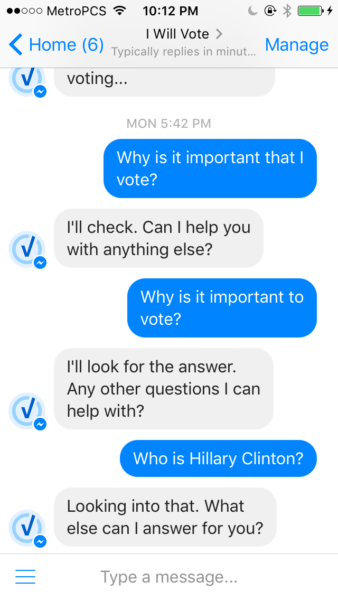


I learn something totally new and challenging on blogs I stumble upon on a daily basis. It will always be interesting to read articles from other authors and practice something from their websites...
ReplyDeleteChatbot Company in India
AI Chatbot
Chatbot Development
You actually have outstanding well written articles. Cheers for sharing with us your website.
ReplyDeleteChatbot Company Kuwait
Chatbot Company Bahrain
Chatbot Company Oman
Chatbot Company Muscat
Chatbot Company Qatar
Chatbot Company Saudi Arabia
Chatbot Company KSA
A great piece that sheds much needed light on AI and Machine Learning Development and its impact on business as there are many new details you posted here. Sometimes it is not so easy to build a "AI and Machine Learning Development Company" without custom knowledge; here you need proper development skills and experience. However, the details you mention here would be very much helpful for the beginner. Here is yet another top-notch solution provider “X-Byte Enterprise Solutions” who render feasible and credible solutions to global clients.
ReplyDeleteKnow more here: https://www.xbytesolutions.com/ai-machine-learning-development-company.php